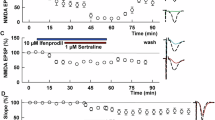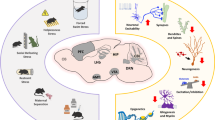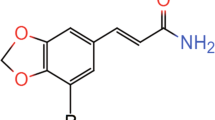Abstract
Previous experiments with the first selective nonpeptide vasopressin V1b receptor antagonist SSR149415 ((2S, 4R)-1-[5-chloro-1-[(2,4-dimethoxyphenyl)sulfonyl]-3-(2-methoxyphenyl)-2-oxo-2,3-dihydro-1H-indol-3-yl]-4-hydroxy-N,N-dimethyl-2-pyrrolidinecarboxamide) have shown that the drug elicits anxiolytic- and antidepressant-like effects following systemic administration. Extrahypothalamic V1b receptors have been suggested to be involved in these effects as evidenced by the findings that hypophysectomized rats were still sensitive to the antistress action of SSR149415. The first objective of the present work aimed at locating V1b receptors in the rat limbic brain using anti-V1b receptor immunohistochemistry. The immunolabeling revealed high densities of V1b receptors in the lateral septum, the amygdala, the bed nucleus of the stria terminalis, the hippocampal formation, and in several cortical areas. Since the lateral septum is well known to participate in the modulation of emotional processes, the second objective of this study went on to evaluate the behavioral effects of an infusion of SSR149415 into the lateral septum and to determine whether its behavioral effects are mediated by this structure. Animals were tested in models classically used for the screening of anxiolytics (ie the punished drinking and elevated plus-maze tests) and antidepressants (ie the forced-swimming test). Bilateral intraseptal infusion of SSR149415 (10 and 100 ng) produced a decrease in immobility time in the forced-swimming test, indicating antidepressant-like effects. In contrast, the behavior of rats in the punished drinking procedure or in the elevated plus-maze test was not modified by intraseptal infusion of SSR149415. These findings suggest that V1b receptors located in the lateral septum participate in the antidepressant- but not the anxiolytic-like action of SSR149415 in rats.
Similar content being viewed by others

Log in or create a free account to read this content
Gain free access to this article, as well as selected content from this journal and more on nature.com
or
References
Aguilera G, Rabadan-Diehl C (2000). Vasopressinergic regulation of the hypothalamic-pituitary-adrenal axis: implications for stress adaptation. Regul Peptides 96: 23–29.
Caffe AR, van Leeuwen FW, Luiten PG (1987). Vasopressin cells in the medial amygdala of the rat project to the lateral septum and ventral hippocampus. J Comp Neurol 261: 237–252.
Contreras CM, Lara-Morales H, Molina-Hernandez M, Saavedra M, Arrellin-Rosas G (1995). An early lesion of the lateral septal nuclei produces changes in the forced swim test depending on gender. Prog Neuropsychopharmacol Biol Psychiatry 19: 1277–1284.
Dantzer R, Koob GF, Bluthe RM, Le Moal M (1988). Septal vasopressin modulates social memory in male rats. Brain Res 457: 143–147.
De Vries GJ, Buijs RM (1983). The origin of the vasopressinergic and oxytocinergic innervation of the rat brain with special reference to the lateral septum. Brain Res 273: 307–317.
Ebner K, Wotjak CT, Holsboer F, Landgraf R, Engelmann M (1999). Vasopressin released within the septal brain area during swim stress modulates the behavioural stress response in rats. Eur J Neurosci 11: 997–1002.
Ebner K, Wotjak CT, Landgraf R, Engelmann M (2002). Forced swimming triggers vasopressin release within the amygdala to modulate stress-coping strategies in rats. Eur J Neurosci 15: 384–388.
Estrada-Camarena E, Contreras CM, Saavedra M, Luna-Baltazar I, Lopez-Rubalcava C (2002). Participation of the lateral septal nuclei (LSN) in the antidepressant-like actions of progesterone in the forced swimming test (FST). Behav Brain Res 134: 175–183.
Everts HG, De Ruiter AJ, Koolhaas JM (1997). Differential lateral septal vasopressin in wild-type rats: correlation with aggression. Horm Behav 31: 136–144.
Folny V, Raufaste D, Lukovic L, Pouzet B, Rochard P, Pascal M et al (2003). Pancreatic vasopressin V1b receptors: characterization in In-R1-G9 cells and localization in human pancreas. Am J Physiol Endocrinol Metab 285: E566–E576.
Graeff FG, Silveira MC, Nogueira RL, Audi EA, Oliveira RM (1993). Role of the amygdala and periaqueductal gray in anxiety and panic. Behav Brain Res 58: 123–131.
Griebel G, Simiand J, Serradeil-Le Gal C, Wagnon J, Pascal M, Scatton B et al (2002). Anxiolytic- and antidepressant-like effects of the non-peptide vasopressin V1b receptor antagonist, SSR149415, suggest an innovative approach for the treatment of stress-related disorders. Proc Natl Acad Sci USA 99: 6370–6375.
Griebel G, Simiand J, Stemmelin J, Serradeil-Le Gal C, Steinberg R (2003). The vasopressin V1b receptor as a therapeutic target in stress-related disorders. Curr Drug Target CNS Neurol Disord 2: 191–200.
Hernando F, Schoots O, Lolait SJ, Burbach JP (2001). Immunohistochemical localization of the vasopressin V1b receptor in the rat brain and pituitary gland: anatomical support for its involvement in the central effects of vasopressin. Endocrinology 142: 1659–1668.
Hurbin A, Orcel H, Alonso G, Moos F, Rabie A (2002). The vasopressin receptors colocalize with vasopressin in the magnocellular neurons of the rat supraoptic nucleus and are modulated by water balance. Endocrinology 143: 456–466.
Landgraf R, Gerstberger R, Montkowski A, Probst JC, Wotjak CT, Holsboer F et al (1995). V1 vasopressin receptor antisense oligodeoxynucleotide into septum reduces vasopressin binding, social discrimination abilities, and anxiety-related behavior in rats. J Neurosci 15: 4250–4258.
Liebsch G, Wotjak CT, Landgraf R, Engelmann M (1996). Septal vasopressin modulates anxiety-related behaviour in rats. Neurosci Lett 217: 101–104.
Lolait SJ, O'Carroll AM, Mahan LC, Felder CC, Button DC, Young III WS et al (1995). Extrapituitary expression of the rat V1b vasopressin receptor gene. Proc Natl Acad Sci USA 92: 6783–6787.
Paxinos G, Watson W (1998). The Rat Brain in Stereotaxic Coordinates, 4th edn. Academic Press: London.
Pellow S, Chopin P, File SE, Briley M (1985). Validation of open:closed arm entries in an elevated plus-maze as a measure of anxiety in the rat. J Neurosci Methods 14: 149–167.
Pesold C, Treit D (1994). The septum and amygdala differentially mediate the anxiolytic effects of benzodiazepines. Brain Res 638: 295–301.
Porsolt R, Le Pichon M, Jalfre M (1977). Depression: a new animal model sensitive to antidepressant treatments. Nature 266: 730–732.
Rabadan-Diehl C, Makara G, Kiss A, Lolait S, Zelena D, Ochedalski T et al (1997). Regulation of pituitary V1b vasopressin receptor messenger ribonucleic acid by adrenalectomy and glucocorticoid administration. Endocrinology 138: 5189–5194.
Schreiber R, De Vry J (1993). Neuroanatomical basis for the antidepressant-like effects of the 5-HT(1A) receptor agonists 8-OH-DPAT and ipsapirone in the rat forced swimming test. Behav Pharmacol 4: 625–636.
Serradeil-Le Gal C, Wagnon J, Simiand J, Griebel G, Lacour C, Guillon G et al (2002). Characterization of (2S,4R)-1-[5-chloro-1-[(2,4-dimethoxyphenyl)sulfonyl]-3-(2-methoxy-phenyl)-2-oxo-2,3-dihydro-1H-indol-3-yl]-4-hydroxy-N,N-dimethyl-2-pyrrolidine carboxamide (SSR149415), a selective and orally active vasopressin V1b receptor antagonist. J Pharmacol Exp Ther 300: 1122–1130.
Treit D, Menard J (2000). The septum and anxiety. In: Numan R (ed). The Behavioural Neuroscience of the Septal Region. Springer-Verlag: New York, pp 210–233.
Treit D, Pesold C (1990). Septal lesions inhibit fear reactions in two animal models of anxiolytic drug action. Physiol Behav 47: 365–371.
Vaccari C, Lolait SJ, Ostrowski NL (1998). Comparative distribution of vasopressin V1b and oxytocin receptor messenger ribonucleic acids in brain. Endocrinology 139: 5015–5033.
Vogel JR, Beer B, Clody DE (1971). A simple and reliable conflict procedure for testing anti-anxiety agents. Psychopharmacologia 21: 1–7.
Wersinger SR, Christiansen M, O'Carroll A, Lolait SJ, Gold PW, Hu S et al (2003). Social aggression is reduced in vasopressin 1b receptor null mice but is elevated in vasopressin 1a receptor null mice. Program No. 838.14. 2003 Abstract Viewer/Itinerary Planner. Society for Neuroscience: Washington, DC.
Yadin E, Thomas E, Grishkat HL, Strickland CE (1993). The role of the lateral septum in anxiolysis. Physiol Behav 53: 1077–1083.
Acknowledgements
We would like to acknowledge M L'Hermitte, C Aliaga, N Moindrot for technical assistance on behavioral studies and D Duverger and B Piveux for advising on perfusion and paraffin embedding.
Author information
Authors and Affiliations
Corresponding author
Rights and permissions
About this article
Cite this article
Stemmelin, J., Lukovic, L., Salome, N. et al. Evidence that the Lateral Septum is Involved in the Antidepressant-Like Effects of the Vasopressin V1b Receptor Antagonist, SSR149415. Neuropsychopharmacol 30, 35–42 (2005). https://doi.org/10.1038/sj.npp.1300562
Received:
Revised:
Accepted:
Published:
Issue date:
DOI: https://doi.org/10.1038/sj.npp.1300562
Keywords
This article is cited by
-
Vasopressin and alcohol: a multifaceted relationship
Psychopharmacology (2018)
-
Differential activation of arginine-vasopressin receptor subtypes in the amygdaloid modulation of anxiety in the rat by arginine-vasopressin
Psychopharmacology (2018)
-
Neuropeptide receptor ligands as drugs for psychiatric diseases: the end of the beginning?
Nature Reviews Drug Discovery (2012)
-
Neurohypophyseal hormones manipulation modulate social and anxiety-related behavior in zebrafish
Psychopharmacology (2012)


